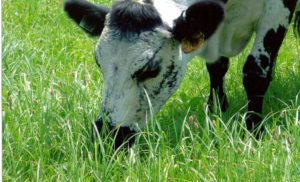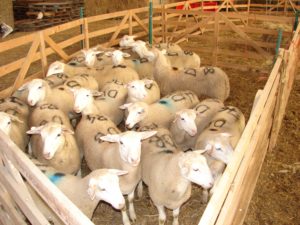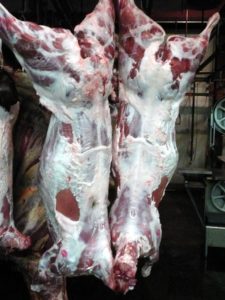Raising and Finishing Lambs on Pasture
“It can’t be done”. I hear that often when the topic of raising and finishing lambs on pasture is being discussed.
Can it be done? Let’s take a look at the history of sheep. Sheep as well as goats were raised in areas that could not support a cow. Or they were raised by people who could not afford to feed a cow. A sheep had the reputation to thrive were a cow wouldn’t. A German saying states: “You can feed ten sheep where a cow would starve to death”. Then why do we assume nowadays that lambs need to be fed grain in order to produce a finished carcass?
In my opinion we’ve strayed away from traditional ways of raising sheep on pasture. Instead, many sheep producers wean somewhat light lambs, so-called feeder lambs, and sell them to a feed lot or put them in the barn and finish them on grain. “Don’t use it and you lose it” goes another saying. In this case, many sheep breeds have lost their ability to finish on grass simply because the selection process for this ability was neglected for as long as there was cheap grain.
Higher grain prices, a revival of pasture based farm systems and the desire for grass-finished meats have now led us to re-invent the wheel and let sheep do what they did for thousands of years: graze on pasture.

Grass and legumes should always be plentiful. Photo by Ulf Kintzel
I think it can be done. First, you need sheep that can thrive on pasture. Large, long-legged sheep with small bellies do not have the rumen capacity to do that. Rule of thumb: The more daylight passes through underneath the sheep’s belly, the less meat there is on this sheep. If you have an existing flock just select those individual sheep that still thrive on pasture and eliminate those that don’t.
If you are starting up or if you want to start over, select a breed of sheep that has not yet lost its ability to thrive on pasture. Some of these breeds come from other continents and are fairly new to theUnited States. The Dorper and the White Dorper sheep fromSouth Africaare such examples. Although there has been already a development towards some grain-dependent show lines within this breed, many Dorpers do well on pasture. Other sheep breeds have been developed in this country such as the Katahdins. If you are not certain if the breed you choose is the right one simply look at the management of the farmer from whom you consider buying your sheep. If he or she raises these sheep on pasture they are likely to work for you.
However, raising and finishing lambs on pasture does not mean turning them loose in a paddock and hoping for the best. It requires a set of skills and knowledge that one needs to acquire. If you don’t have that set of skills you will find the learning curve steep at times.
The pasture needs to be nutritious and dense with a high percentage of legumes and a well balanced pH level. It needs to be harvested (grazed) at the right time of maturity. Rotational grazing is a necessity. If you choose continuous grazing you will soon run out of desirable forage and as a result the sheep won’t eat as much. Thus, the daily gain of weight will go down immediately. Water and minerals should be supplied at all times. In the summer, shade should be provided and in the winter, shelter should be accessible. I encountered many situations were one or any of the above was not provided. I was told “They can take it”. Yes, they could but that wasn’t really the issue. A sheep farmer should not measure the sheep’s ability to survive.
Instead, he or she should do everything to get the highest daily gain of weight possible. That goes beyond providing nutrition. It also means that the sheep need to have species-specific comfort without pampering them.
The flock also needs to be free of disease in order to thrive. One of the most common diseases that affect the bottom line is hoof rot. Sheep with hoof rot limp, are in pain, and don’t move more than absolutely necessary. A sheep in a grazing system will need to be able to move in order to forage.
One needs to be able to evaluate a carcass while the lamb is still alive in order to know when to harvest. Even if all the above is done correctly, when do you know when the lamb is “finished”? Let’s look first at the definition of ”finished”. A lamb is finished when it has the right relation between bone, meat and fat. While there are some breeds which lambs are basically always finished no matter what the weight is, there are others that grow unevenly. First, they are boney and there is not much meat, let alone fat. Then the meat yield increases, but there is still little to no fat cover yet. If a lamb is harvested at that stage it will result in a “blue” carcass. Then the lamb develops a fat cover and before too long that fat cover may grow into a layer that is too thick. Producing fat instead of meat is a waste of forage. It needs to be harvested before that happens. And what weight is that going to be? Well, that is breed specific. My White Dorper lambs have their ideal butchering weight between 80 and 95 pounds live. Up to 105 pounds they aren’t too fat yet. However, it takes more input to get these additional pounds. Smaller breeds like Southdown and Border Cheviots reach this ideal weight earlier but are also lighter. This makes them ideal to produce hothouse lambs. For larger breeds like Hampshire Sheep or Suffolks this ideal weight is higher but they will reach it later.
Well-finished grass-fed lambs are still somewhat rare and have the potential of fetching a premium price. Maybe I’ve convinced you that you can do it!
Copyright 2010 Ulf Kintzel. For permission to use either text or photographs please contact the author at ulf@whitecloversheepfarm.com




Hi Ulf,
I have been doing work here in Nova Scotia, Canada with grass fed beef for a few years now. Both collecting research data in the field, as well as on the carcass. I bought my own farm a couple years back and took over the flock of sheep from my father. As you and I both know well back in the day it was ‘the bigger, the better’, which isn’t the case nowadays with prices of supplements going through the roof. Having done some research myself on sheep, there seems to be little to none. Which is why I’m at your door step.
Here in Nova Scotia the weather patterns and conditions to you would be fairly similar, as you’re only located in New York. The only difference would be moisture content and there the lack of here. That being said I was hoping to rack your brains on a few specs.
With the cattle we did a rotational grazing pattern, moved every 2-3 days, measuring gains through out the summer. The cattle being used were only borrowed, so those able to be slaughtered were purchased, slaughtered, and measured.
As I’m looking to take this down the path of sheep, I was hoping you would be able to fill me in on your process, the measured controls of the system, and what the outcomes of the operation are.
Thanks very much in advance for your time!
Sam Cripps
Wow))